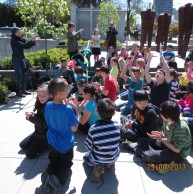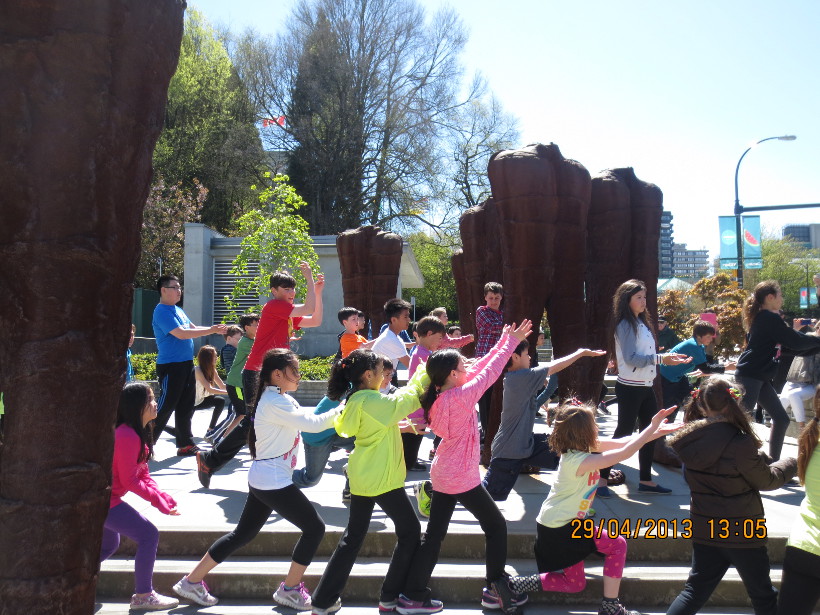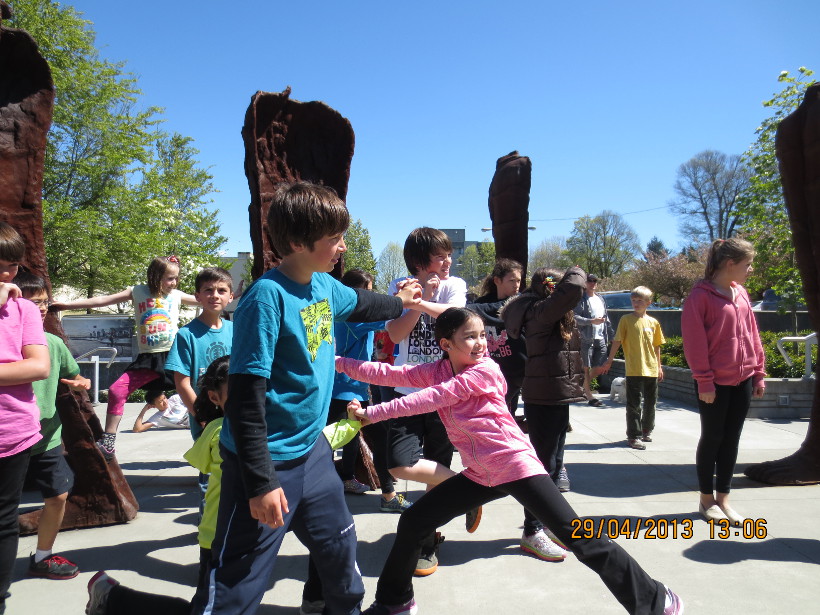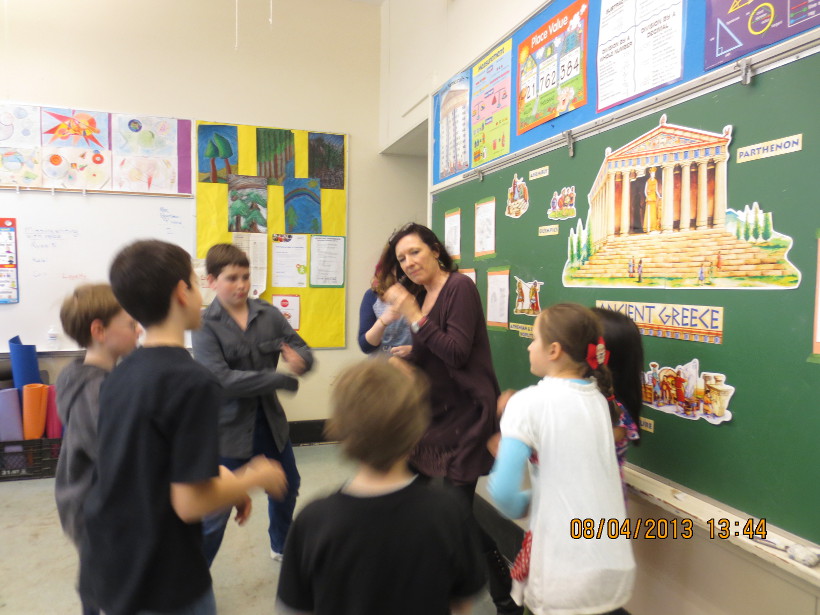Kerrisdale Gr 3 and 6/7
Arts Education, Health and Career Education, Language Arts, Social Studies
School:
Kerrisdale Elementary School, Vancouver
Teachers:
Linda Backerman and Jane Spencer
Artists:
The Contingency Plan – Vanessa Goodman and Jane Osborne
Class:
Grade 3 and Grade 6/7
Sources of Inspiration:
Vancouver Biennale Legacy: Walking Figures at Canada Line City Hall Station
Overview:
The students were inspired by the headless Walking Figures to express ideas around Leadership for Social Change, and how they themselves could represent positive leadership each and every day. The activities designed by the classroom teachers and two dance artists help students understand the qualities of a leader and the many faces of leadership. Students start with acquiring a better understanding of self, and how much more can be achieved when they work together. The final stage is to realize the contribution they can make to their community.
BIG IDEAS:
Leadership for Social Change
Guiding Question:
How can we become good community leaders by making the right choices and decisions?
Curriculum Access:
Health and Career Education (Leadership and Decision Making), Language Arts (Critical and Media Literacy, Connecting to Stories), Social Studies (Sources of Power and Social Justice), Arts Education – Dance
Learning Process:
Through the Health of Career Leadership Challenge Program, the students wrote about their role models and their personal leadership experiences. Both classes studied the Walking Figures and use that to facilitate discussion around the guiding question. After participating in drama and movement games led by the artists, the students were encouraged to create movement inspired by the words that describe positive leaders and good role-models in their lives. The students practiced leadership through this collaborative, cross-grade creative process. The project culminated in a powerful, expressive public performance at the Walking Figures.
Student Creations:
The students created an oral and kinesthetic expression of the qualities they associate with leadership through the public performance of “The Many Faces of Leadership.”
Taking Action:
The students displayed traits and characteristics of good leadership such as accountability, good listening, respect, positivity and self-confidence throughout the shared creative process. In both our 6/7 class and in the Grade 3 class, some students adopted a leadership role as they assisted their peers in learning the dance.
Timeline:
Jan
- Leadership Challenge (working as a group) Develop an awareness of self-including strengths, areas of growth (stretches), learning style, MMTIC (children’s version of MBTI), needs, feelings, beliefs and values. Wrote about role models, their stories and identified some of the qualities that made them successful.
Feb
- Be careful observers of themselves, others and to keep an open mind in respect to capabilities and preferences
- A rock climbing activity to test going beyond their comfort zone
Mar
- Working in Group: Hands-on activities with a focus on everyone have something unique to contribute
- A restaurant challenge: design, plan, coordinate, cook and serve three course meals to peers and judges within a 90 minute time frame
- Two classes met to discuss the Biennale sculpture and project. Students engaged in a carousel activity in which they answered open ended questions about the sculptures such as: Why were they Headless? Why are the figures wrapped? What does their stance suggest to you?
Apr
- Begin sessions with dance artists
- Explored responsibility towards self and each other in the community
- Began learning how words, themes, and ideas could be translated into movement and dance
- Thought of examples of great leaders and ways to describe them
- Combining the two previous activities, created movement for characteristics and traits that describe good leaders
- Created awareness of your spatial surroundings and how to be mindful of others
- Created a cohesive dance with the students that represent each person’s expectations of leadership and social justice while simultaneously forming an encouraging environment where each student had a creative voice and confidence to lead and to listen
- Visited the site of The Walking Figures in order to familiarize the students with the location, fostering confidence and support
- Performed dance and spoken words at Walking Figures
May
- Conducted final debrief session where students reflected on the process of the project
- Written reflections and prepare case document
Reflections:
Teacher:
At first, there were many reservations about taking on an ambitious project like this that required cross-grade collaboration. The teachers did not know how it was going to work out, having a group of students that they had never taught before, come together with their own class and as a collective group accomplish something together. However, the process went much better than initially expected and the older students demonstrated great leadership qualities through mentoring their younger peers not only during practices but also looking out for them during the trips to the site. The Grade 3 teacher Linda Backerman was impressed with how some of the students went home to practice and really learn the dance, taking ownership of the project and displaying confidence in the work that was done. The Grade 3 students enjoyed being collaborators and participants in a performance with their big buddies. Students were united by a sense of trust and common purpose for the creation of the public performance. The students were able to surprise the teachers with their depth of thought and insight towards the process of the learning during the reflection period.
Grade 6/7 Teacher: Jane Spencer:
The project was an amazing culmination of our learning since the beginning of the year. It was challenging in many ways (the repetition, the large amount of time required for the creative process, space constraints) but there was an enormous amount of learning that took place. In addition to their prolonged reflection on the qualities of leadership, students benefited from the experiential learning around working together, the need for focus, the need to pay attention to timing and cues, the need for patience and tolerance of differences, and the pleasure of performing for the public in the sunshine and the escape from pencil and paper activities.
Artist(s):
This was an adventure for us. We began the project with many ideas that we thought we could try, and an overall game plan for creating a performance but recognized that much would be discovered in the room, with the students. We were impressed by the courage, openness and general willingness that the students displayed when being asked to move their bodies in new and (could be perceived as) strange ways. The cooperation between the two grades was amazing to see and be a part of, with Grade 6/7 displaying an incredible level of responsibility and the Grade 3’s some fabulous enthusiasm. Each grade elevated some aspect of the other and through respecting each other, the space and the tasks, a safe environment was created where no one felt ostracized, inhibited or overwhelmed. There was almost an instantaneous sense of ownership from all the students and this really helped us to see how through movement and ensemble work, these ideas of leadership, good citizenship and being a positive role model were articulated. We were excited to see a sense of pride in the students when they performed and were really impressed with all the work they did. We are also grateful for the support of the wonderful teachers and teacher’s aides at Kerrisdale.
Students: When the students were asked how it made them feel to dance as a group, to perform for each other and to attach movement to abstract ideas, they used words like: Unstoppable, powerful, awesome, calm, exhilarated, ecstatic, …Some of the students found the whole process to be an exciting experience because they realized that not every class was able to partake in this activity yet they were and felt privileged in doing so. Some of the students would have liked some more variety in the dance; they felt that the performance would have been more creative had there been more dance moves for them to learn. There was a general sentiment that expressed that it was nice to go to a different setting to do a performance. It was also exciting to go out of their normal routine and do something out of their comfort zone.
Reflecting on leadership, some described the process saying that even just reciting the words and accompanying them with the respective dances seemed to project the ideas behind the performance. Even the process of travelling to the location and performing showed leadership qualities amongst some of the students.
The students enjoyed coming up with the creation of the dance moves; it was not something that was created for them. Finishing the performance gave a sense of pride and achievement due to finally finishing it after having worked on it for so long.
A suggestion was made that perhaps the groups could have been divided into sections in order to give some students who were comfortable with the dance routine more roles and responsibilities.
Some liked the repetitive moves of the dance as it gave them the opportunity to actually remember the dance.
Some students liked the collaboration aspect of the project, working with students from a different class and age group was a different experience. Working towards a larger goal and a sequential process that led to an end also was pleasing.
Related Material
 BIG IDEAS in Social Responsibility Part 2
BIG IDEAS in Social Responsibility Part 2



